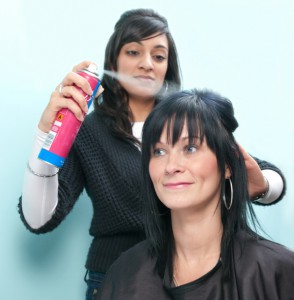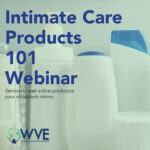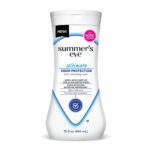 Due to a lack of government oversight, many products used in hair and nail salons contain a number of hazardous chemicals that may harm your health. Below are some particularly toxic chemicals to avoid in salon products, along with the health problems these chemicals are linked to.
Due to a lack of government oversight, many products used in hair and nail salons contain a number of hazardous chemicals that may harm your health. Below are some particularly toxic chemicals to avoid in salon products, along with the health problems these chemicals are linked to.
Together, you and your stylist can give your salon visits a makeover.
Download this fact sheet and bring it to your salon to ask your stylist or manicurist if any of the chemicals listed are in the products she uses on you. If yes, maybe you can start a conversation about switching to a safer alternative, both for her health and yours.
What Salon Workers Need to Know
Have you experienced breathing problems, headaches, skin rashes, or other health problems while at work? Did you know that many products used in hair and nail salons contain a number of hazardous chemicals that may pose health risks to you and your clients? Unfortunately, salon workers commonly report negative health effects associated with their work. Long term studies of salon workers have also reported higher risks of chronic conditions, including certain cancers, immune diseases, asthma, and higher risk of some birth defects in their children.
For many chemicals, hazardous ingredients can be avoided altogether by purchasing alternative products. For those that can’t be avoided, you can take precautions to protect your health.
Where to Look for Hazardous Ingredients
- Ingredients in salon products can sometimes be found on the product label, although manufacturers are not required to fully list all ingredients in products sold for professional use.
- Stylists can look at the Safety Data Sheets associated with the product, where some hazardous ingredients (although not all ingredients) must appear. (These sheets should have been sent along with the products).
- Stylists can call the manufacturer’s customer service line for more information.
Harmful Chemicals to Avoid
The chemicals on this list are those which can be reasonably avoided by using currently available products containing safer alternatives.
| Chemical Name | Found in These Products | Symptoms of Exposure | Potential Long Term Effects |
|---|---|---|---|
| Dibutyl Phthalate | Nail Polish | Nausea, dizziness, eye and skin irritation | Reproductive toxin, birth defects |
| Formaldehyde or methylene glycol | Nail hardener, nail polish, keratin hair straighteners | Breathing problems, coughing, wheezing, skin rashes, eye nose, throat irritation | Cancer, dermatitis |
| Toluene | Nail polish, nail glue, hair dye, wig glue/hairpiece bonding | Dizziness, headaches, skin rashes, eye, nose, throat irritation | Liver damage, kidney damage, birth defects, pregnancy loss |
| Methyl Methacrylate (MMA) | Artificial nails | Breathing problems, chest tightness, eye, nose, throat irritation, headaches, confusion | Loss of smell, reproductive toxin, asthma |
| Cyclopentasiloxane or cyclomethicone | Flat iron sprays, thermal protection sprays | Under the high heat of a flat iron, cyclopentasiloxane creates formaldehyde. Formaldehyde leads to breathing problems, coughing, wheezing, skin rashes, eye, nose, throat irritation | Formaldehyde exposure may cause cancer, dermatitis |
| Styrene | Hair extension glue; lace wig glue | Vision problems, trouble concentrating, tiredness | Cancer |
| Trichlorethylene | Hair extension glue; lace wig glue | Dizziness, headache, confusion, nausea, eye and skin irritaion | Liver damage, kidney damage, dermatitis, double vision |
| 1,4 Dioxane | Hair extension glue; lace wig glue | Eye and nose irritation | Cancer, liver damage, kidney damage |
| 2-butoxyethanol or Ethylene glycol monobutyl ether | Disinfectants, cleaners | Headache, eye and nose irritation | Reproductive toxin |
Harmful Chemicals to Be Mindful Of
The following list of chemicals are those known to be harmful to health, but which may be difficult to avoid due to a lack of safer available alternatives. Information about these chemicals is provided here to help you better identify which chemicals or products might be most responsible for symptoms you are experiencing.
| Chemical Name | Found in These Products | Symptoms of Exposure | Potential Long Term Effects |
|---|---|---|---|
| Quaternary Ammonium Compounds or “dimethyl benzyl ammonium chloride” | Disinfectants and cleaners | Skin, eye and nose irritation | Asthma |
| P-phenylenediamine | Hair dyes, black henna tattoos | Skin irritation | Dermatitis |
| Glyceryl thioglycolate | Permanent wave solutions, “acid perms” | Skin irritation | Dermatitis |
| Ammonium persulfate | Hair bleach | Eye, skin and nose irritation, coughing, shortness of breath | Asthma, dermatitis |
| Ethyl methacrylate | Artificial nails | Eye and skin irritation, rashes on eyelids, face or nect, difficulty concentrating, coughing, shortness of breath | Asthma |
| Acetone | Nail polish remover, hairspray | Eye, skin and throat irritation, dizziness | Eye, skin and throat irritation, dizziness |
| Acetonitrile | Nail glue remover | Eye, skin and throat irritation, face flush, chest tightness, nausea | Weakness, exhaustion |
| Butyl acetate, ethyl acetate or isopropyl acetate | Nail polish, nail polish remover, wig glue/hairpiece bonding | Eye, skin and throat irritation, headaches, dizziness | Eye, skin and throat irritation, dermatitis |
| Methacrylic acid | Nail primer, eyelash glue | Skin burns, eye, nose and throat irritation | Kidney damage, dermatitis, reproductive toxin |
Note: These lists are not exhaustive. More research is needed to both better identify hazardous chemicals used in salon products, and to develop safer chemical alternatives for harmful chemicals commonly in use.
Best Practices to Reduce Exposure
Some harmful chemicals may be difficult to avoid in salon work, due to the current lack of viable alternatives and the lack of ingredient disclosure directly on product labels. For these chemicals, the best advice is to reduce your exposure as much as possible by:
- Ensuring good ventilation in the salon
- Keeping trash cans tightly closed
- Using small amounts of the product when performing services
- Wearing nitrile gloves and protective clothing
- Washing hands before and after use
For additional advice and resources on protecting your health in the salon go to: http://nailsalonalliance.org/nail-salon-workers/
Click here, for more information and resources about toxic chemicals in salon products, salon worker health and safety issues, and how you can get involved, and sign-up to receive important updates from Women’s Voices for the Earth.





